|
Run clean, run fast!
by Alicia Moore, Moore Collies
A Day in the Life of an AKC Agility Trial
Dog Agility is a sport where you and your dog work together to accurately complete a course of obstacles within the time allotted. That may not sound very exciting or challenging, but it is a true team sport and takes years to get really good and participate successfully at the Masters levels. The connection that is built between handler and dog during this time is unmatched and your bond can extend beyond personality to health and fitness.
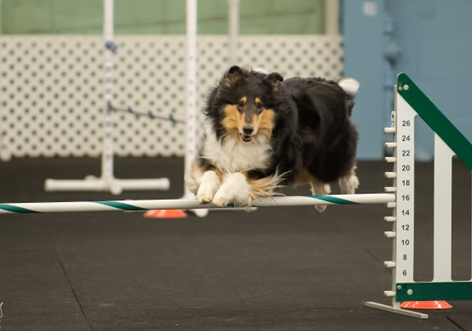
Kenzie, PACH Moore’s Alainn Aoife, RE, HSAs, NA, MXPB, MJP5, MJPS, PAX, XFP, CCA VX
Before the agility trial
While there are several organizations that offer agility trials, trialing with AKC begins by first registering your dog as a pure breed or mixed according to AKC’s guidelines. More and more trials are inviting dogs who may not have full pedigrees to compete so check the show’s Premium to confirm. These Premiums have all the necessary information related to the trial and can be obtained online either through AKC.org or through the hosting dog club’s website.
Our breed loves to work WITH us, and to please us. They are overjoyed when you are happy . . .
Once you’ve trained and are ready to enter a trial, be sure to plan several months ahead as many trials open well before the trial date and have a limited number of entries that can be accepted. Most trials are “first received” meaning the entries are taken in the order they come to the secretary’s address. If this is the case, plan to have your entry arrive on the day of opening. Another format, “random draw,” is used less frequently and you need only to get your entry in before the closing date to be included in the draw. In both cases, waiting lists are created if there are more entries than the trial can accept. You will be notified where you are on the list and asked if you are willing to see if you get accepted should others drop out. One way people might “pull” from a trial and allow you to move off the wait list is if their bitch comes into "season." Of course, this could also happen to you if your girl is intact so know that trials offer full or partial refunds for bitches in season with a letter from a veterinarian.
Some trials give preference to those who are willing to volunteer. Volunteering is a wonderful way to learn all aspects of a trial and gets you involved in the community quickly. You may even get a free lunch out of the deal! Most agility entries are still done with a paper and pen, but more and more secretaries are offering online options. Again, be sure to check the Premium for details and know that there is usually a small convenience fee. If you don’t enjoy filling our forms, or have realized your handwriting needs some getting used to, there are a couple of sites that can help. LabTestedOnline.com enables you to search for trials, save your information and either print entries or enter online.
On trial day
By the time of a trial, you will have received both a preliminary and final confirmation from the trial secretary. In the latter, there will be a judging program that will provide the order in which classes will run. Some secretaries will approximate run times, but don’t count on that as absolute. Regardless, you will want to arrive in plenty of time to set up, get settled, walk your dog and check in for your runs.
You will have two choices as to what to do with yourself and your dogs between runs. Most people set up their portable crates and mat/tarp indoors which will require you to get to the site early for a good spot. You will learn a lot from seeing everything that people bring for their dogs from the basics (treats and crate) to the prepared (fans, batteries, different collars, multiple leashes, video cameras, chairs for humans, dog bedding and more!). You may eventually feel as most of us do that you are “moving in” after the fourth trip to the car!
Inside, you will find a table where you can pick up your number and course maps. As you familiarize yourself with the site, you will also find the running orders taped up somewhere and will need to put a checkmark before your dog’s name to confirm you are present and running.
AKC offers four types of classes: Jumpers with Weaves (JWW), Standard (STD), Fifteen And Send Time (FAST) and Time To Beat (T2B). Within the first three, there will be multiple levels based on accomplishment: Novice, Open, Excellent and Masters. T2B only has one level for all dogs.
Within each are different heights for dogs of the corresponding heights. Both the Premium and AKC.org will have the jump heights listed with the allowed heights of the dogs. You will need to get your dog measured at the trial in order to receive your “permanent” height card. Be sure to check with the secretary to find out what time dogs will be measured.
To make things more complicated, within each class you may choose to run your dog at the “Regular” or “Preferred” height where Preferred dogs run at a height 4” shorter. There are many different philosophies as to how to use the “Preferred” height. Some use it for dogs who might not be as capable physically at running their regular height, others use it for older dogs who can no longer jump their full height, and still others use it for green dogs who are still learning the game. You and your trainer should decide what’s best for your individual dog.
A personal day-in-the life
Recently I was entered in the Weimaraner Club of the Washington D.C. Area trial, or “Weim Trial” for short. Here’s how my day played out:
This one-ring trial began at 7:45 a.m. with 141 Masters/Excellent JWW runs followed by 20 Open JWW runs before the Novice JWW class. I usually plan for about one minute/run and don’t account for briefings, walk-throughs or course changes and this usually puts me at the trial in plenty of time. I have trialed at this facility many times before so I knew that with only one ring and the resulting smaller total number of participants, parking wouldn’t be an issue.
I chose to set up my tarp and crates in a relatively quiet and cool place preferred by my dogs. Many people set up personal chairs ringside since there is seldom seating at the site. Thankfully, agility competitors have an unspoken “musical chairs” policy where you can sit in the chairs belonging to others until the owner comes up and needs his or her chair.
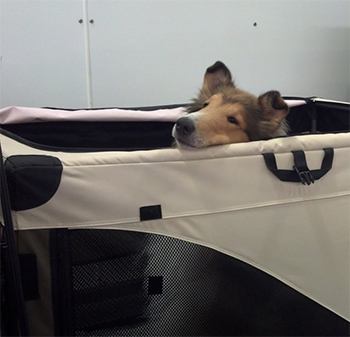
Caoilainn, CH Moore’s Aileen Aednat, RE, PT, NA, NAP,
MJP3, MJPB, XFP
Once settled, I went to the table to retrieve my number which is a sticker with my dog’s running number and call name. Their call name is basically what you call them. Most AKC registered dogs have a different show name. Nearby, the course maps were set out so I grabbed the ones for my classes and set off to find the check-in sheets/running orders. As sometimes happens, my two girls were set to run back-to-back which I knew wouldn’t work. However, per the process, I knew I would work with the gate person and the judge, if necessary, to move the dogs in the order. Most judges are understanding of running order conflicts and are happy to work things out.
The connection that is built between handler and dog during this time is unmatched and your bond can extend beyond personality to health and fitness.
Before each class there is a judge’s briefing where the judge will share reminders and answer any questions. The judge will also remind you to have fun when she sees all of the serious faces staring back at her! “Run clean, run fast!” is my favorite thing to hear in a briefing – sets the right tone for me! Following the briefing you are allowed to walk the course for eight minutes. In large classes such as Masters/Excellent, there will be multiple walk-throughs broken according to height. You will be asked to walk with your height and then that group will run, followed by another height’s walk and run, and so on. The judge will alert you as to how the walk-throughs will be done during the briefing.
With some experience, you will figure out the timing for when to get your dog ready before your run. If you know you want to go get your dog when there are, for example, 10 dogs in front of you, you can identify which dog that is on the running order which will become your “marker dog.” My Collies make for good marker dogs between all those Border Collies!
I have developed a warm up routine that includes a rub down, warm up trotting, a few jumps and maybe a quick potty run. I know that when I am about fours dogs from going into the ring, the person at the gate will start calling my dog to make sure we are ready. Everyone has their own routine and way of getting their dogs ready – I make sure that while I’m revving mine up, I’m not disturbing other dogs, including those in the ring.
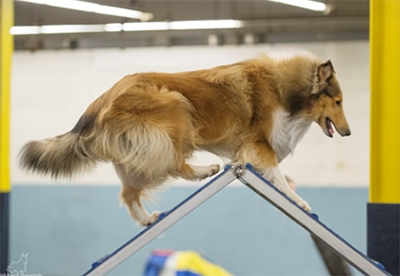
Caoilainn, CH Moore’s Aileen Aednat, RE, PT, NA, NAP, MJP3,
MJPB, XFP
The first class at this trial was the JWW format that must have Jumps and Weaves, as the name implies. It may also have tunnels but did not on this day. My first run was with my youngest bitch, Caoilainn. She is a bit fearful, and her main motivation is food, so her favorite activities are conformation and tracking. After that, she likes practicing agility, as she gets lots of treats, then rally and obedience. She is an elegant and agile jumper and her weaves are the fastest of my dogs. On this morning, she "dropped" a bar, which in all classes but FAST, gets you an NQ (non-qualifying score) in AKC agility. I ignored that, as me getting upset does nothing for either of us, and completed the course successfully with a happy girl alongside me.
Both of my other agility dogs, Kenzie and Peyton, brother and sister, ran clean and “Q’d” or Qualified. While a dropped bar is always an NQ, dogs in Novice can have errors and have three tries to finish the weave poles. Open allows fewer mistakes, yet at all levels there are course times under which you must finish.
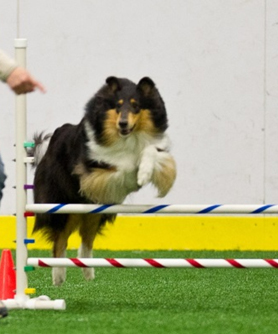
Kenzie, PACH Moore’s Alainn Aoife, RE, HSAs,
NA, MXPB, MJP5, MJPS, PAX, XFP, CCA VX
Next up was FAST which is considered a “game” class. You get to determine your own course among 15 obstacles and there will be a short sequence you must complete cleanly and in the exact order, referred to as the “Send” that is done at some distance from your dog and the obstacle. Bonus points are earned for completing the Send correctly and points are assigned to each obstacle. The object is to get the points you need to “Q” in the time allowed. The points requirement, time allowed and Send distance vary for Novice, Open and Masters/Excellent levels.
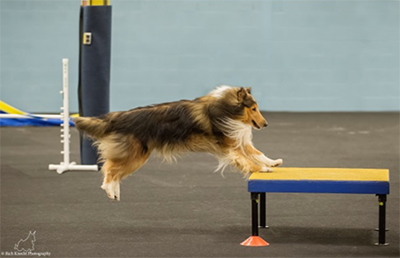
Peyton, GCH CH Moore’s Lord Peyton, RE, PT, NA, MXP2, MXPB, NAJ,
MJP2, MHPB, XFP, NDD, CCA VX
Our third and final class for the day was STD which has all of the obstacles required by AKC including the “Contact” elements, dog walk, A-frame and teeter. Many obstacles pose training challenges to dogs as they progress and my Caoilainn had her issues with the dog walk. With patience and careful training we got her through her issues and on this day she Q’d beautifully with Peyton and Kenzie following suit. Special treats all around!
Agility builds special bonds
Our breed is very tuned into us. My dogs are especially so, as they are all trained to alert me when my blood sugars go low. I am a Type 1 Diabetic, and until the advent of the continuous glucose monitor (CGM), I would spend many a day in the ER recovering from severely low blood sugars. Kenzie decided to let me know on her own, without any guidance. She has saved my life many times. The CGM is not infallible, but she is! I know, for instance, that if she decides not to run, I must check my blood sugar and ask to be moved to the end of the line-up before I run. This hindered us early on, as I would get so nervous I would ignore her warnings and run her while low, which resulted in refusals, and her not even going into the ring.
Besides being physically ready, for me, the most important component I have found to not being nervous while running is to be prepared. If I know my dogs and I have the skills we need to complete the course, I am a lot more confident, and through my confidence, my dogs are as well. The time spent with my dogs connecting, working and performing well as a team makes even a bad day at a show better than a good day at the office!
I hope this article gives you a good base of understanding about running agility. The AKC website has more detailed information about class requirements and more. My hope is that you see that agility is a team sport where you and your dog compete as one. Each run is like a miracle. It is you and your dog. Your job is to let your dog know where to go, which obstacle to tackle, which direction to turn. Their job is to complete the obstacle as they have been taught. It is the most amazing feeling to run with your dog and have them read your instructions almost magically! It is even more amazing that they WANT to do this, just because you ask them!! Our breed loves to work WITH us, and to please us. They are overjoyed when you are happy, and the end of a good, fast, accurate run is something that gives me tears of absolute joy every time it occurs.
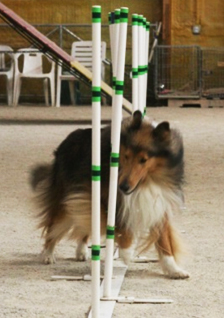
Peyton, GCH CH Moore’s Lord Peyton,
RE, PT, NA, MXP2, MXPB, NAJ,
MJP2, MHPB, XFP, NDD, CCA VX
I hope I have encouraged folks to try this awesome sport with their Collie.
Run clean, run fast!
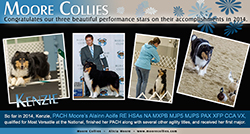
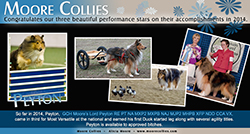
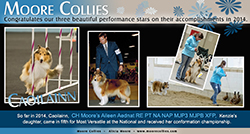
Alicia Moore, Moore Collies, www.moorecollies.com and
Kenzie - PACH Moore's Alainn Aoife RE HSAs NA MXPB MJP5 MJPS PAX XFP, CCA VX
Peyton - GCH CH Moore's Lord Peyton RE PT NA MXP2 MXPB NAJ MJP2 MJPB XFP NDD, CCA VX
Caoilainn - CH Moore’s Aileen Aednat RE PT NA NAP MJP3 MJPB XFP, CCA VX
and my husband Tom, who helps me invaluably throughout my trials
^ Back to top
|